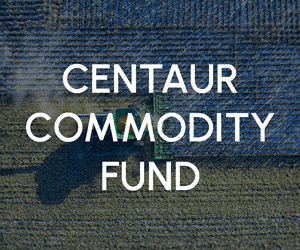Analys
Bearish momentum may return but strategic buying is starting to kick in

EUA price action: The seeds of the rally may have come from Red Sea troubles, higher freight rates and higher ARA coal prices. Add in record short positioning in EUAs, nat gas being cheap relative to oil in Asia, participants in the EU ETS purchasing EUAs strategically, rising temperature adj. nat gas demand in Europe (though absolute demand still very, very weak due to warm weather) and lastly a weather forecast pointing to more normal temperatures in North West Europe. And ”Bob’s your uncle”, the EUA Dec-24 price rallied 10.8% from EUR 52.2/ton on Feb 26 to EUR 57.84/ton ydy.

It is normal with short-covering rallies in bear markets. What puzzled us a little was the involvement of coal prices in the rally together with nat gas and EUAs. Did the upturn in coal prices come from the Chinese market with participants there maybe sniffing out some kind of imminent, large government stimulus package and front-running the market? No. There has been no rally in iron ore and the upturn in coal prices in Asia have been lagging the upturn in ARA coal prices.
Did the rally come from the Utility side in Europe where Utilities jumped in and bought Coal, Gas and EUAs and selling power against it? Probably not because forward fossil power margins are still very negative.
The most plausible explanation for the upturn in coal prices is thus Red Sea troubles, higher dry freight rates and higher ARA coal prices as a result. ARA coal prices bottomed out on 14 Feb and then started to move higher. The Baltic dry index started to rally already in mid-January. This may have been the seeds which a little later helped to ignite the short-covering rally in nat gas and EUAs. Add in a) Record short positioning in EUA contracts by investment funds with need for short-covering as EUA prices headed higher, b) Japanese LNG trading at only 58% versus Brent crude vs. a 2015-19 average of 73% thus nat gas was cheap vs. oil, c) Participants in the EU ETS starting to buy EUAs strategically because the price was close to EUR 50/ton, d) Gradually improving nat gas demand in Europe in temperature adjusted terms though actual.
Mixed price action this morning. Bearish momentum may return but strategic buying is kicking in. Today the EUA price is falling back a little (-0.3%) along with mixed direction in nat gas prices. The coal-to-gas differential (C-t-G diff) for the front-year 2025 still looks like it is residing at around EUR 47/ton and lower for 2026 and 2027. We expect C-t-G diffs to work as attractors to the EUA price from the power market dynamics side of the equation. Thus if nat gas prices now stabilizes at current levels we should still see bearish pressure on EUAs return towards these C-t-G diff levels. The forward hedging incentive index for power utilities in Germany is still deeply negative with no incentive to lock in forward margins as these largely are negative. Thus no normal purchasing of EUAs for hedging of power margin purposes.
That said however. We do see increasing interest from corporate clients to pick up EUAs for longer-term use and strategic positioning and that will likely be a counter to current bearish power market drivers. Even utilities will likely step in a make strategic purchases of EUAs. Especially those with coal assets. Irrespective of current forward power margins. An EUA price below EUR 60/ton is cheap in our view versus a medium-term outlook 2026/27 north of EUR 100/ton and we are not alone holding the view.
The Baltic dry index (blue) bottomed in mid-Jan and rallied on Red Sea issues. European coal, ARA 1mth coal price (white) bottomed on 14 Feb and then rallied.
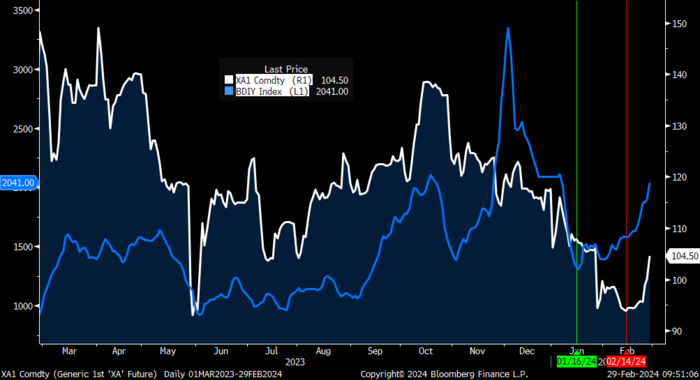
ARA 1mth coal price in orange starting to move higher from 14 Feb. EUA Dec-24 price bottomed for now on 26 Feb
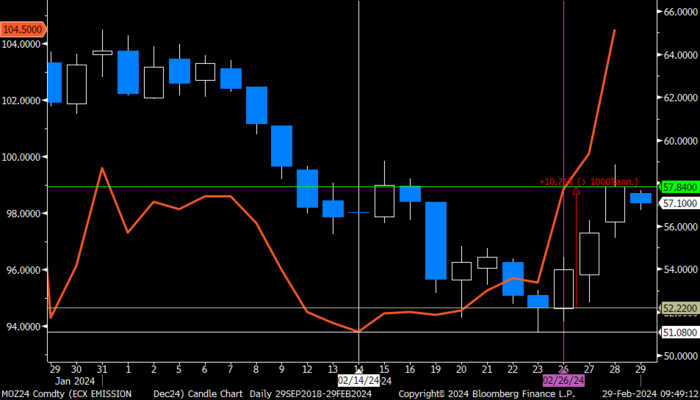
Net speculative positioning in EUAs by financial players. Record short
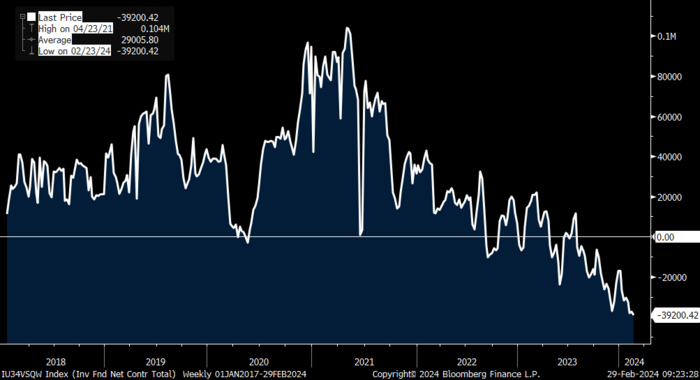
Price of Japanese LNG vs price of TTF nat gas as a spread in EUR/MWh. Rising price of Japanese LNG vs. TTF. But this could be coming from changes in LNG freight rates
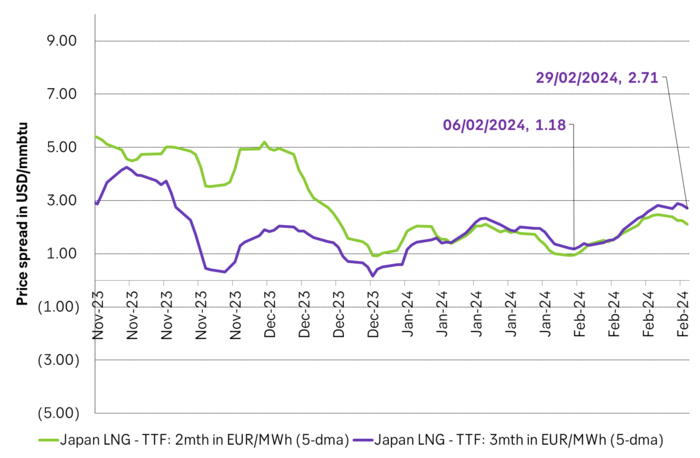
Price of Japanese LNG vs. Brent crude traded all the way down to 58% making it cheap in relative terms to oil.
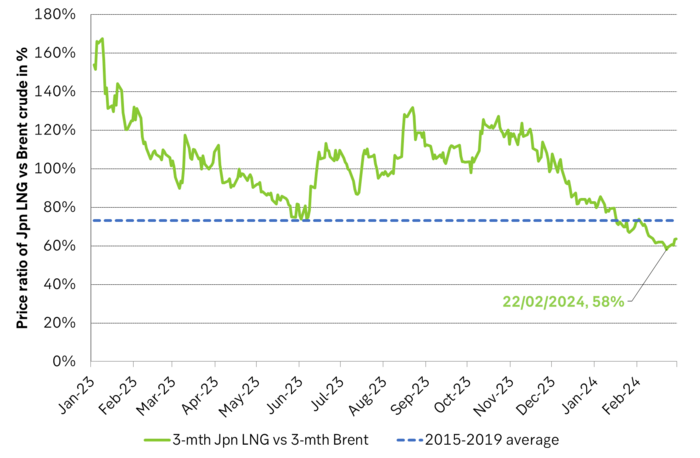
The German forward hedging incentive index just getting more and more negative
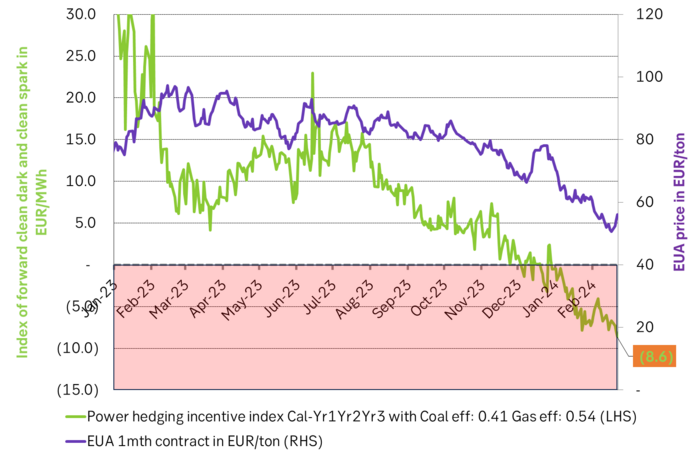
Forward EUA prices in green (today’s prices) and the EUA balancing price for Coal power vs Gas power in lilac. The latter is calculated with today’s nat gas prices and closing prices for ARA coal from ydy. In a medium-tight EUA market the Coal-to-Gas differential in lilac will typically be an ”attractor” for the EUA price in terms of power market dynamics.

Analys
Tightening fundamentals – bullish inventories from DOE

The latest weekly report from the US DOE showed a substantial drawdown across key petroleum categories, adding more upside potential to the fundamental picture.

Commercial crude inventories (excl. SPR) fell by 5.8 million barrels, bringing total inventories down to 415.1 million barrels. Now sitting 11% below the five-year seasonal norm and placed in the lowest 2015-2022 range (see picture below).
Product inventories also tightened further last week. Gasoline inventories declined by 2.1 million barrels, with reductions seen in both finished gasoline and blending components. Current gasoline levels are about 3% below the five-year average for this time of year.
Among products, the most notable move came in diesel, where inventories dropped by almost 4.1 million barrels, deepening the deficit to around 20% below seasonal norms – continuing to underscore the persistent supply tightness in diesel markets.
The only area of inventory growth was in propane/propylene, which posted a significant 5.1-million-barrel build and now stands 9% above the five-year average.
Total commercial petroleum inventories (crude plus refined products) declined by 4.2 million barrels on the week, reinforcing the overall tightening of US crude and products.
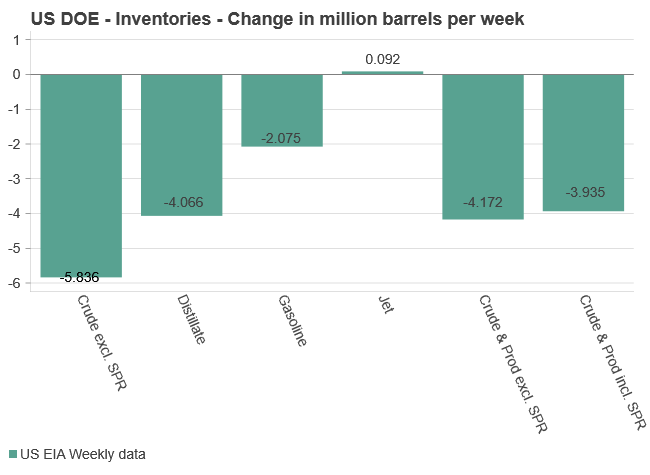

Analys
Bombs to ”ceasefire” in hours – Brent below $70

A classic case of “buy the rumor, sell the news” played out in oil markets, as Brent crude has dropped sharply – down nearly USD 10 per barrel since yesterday evening – following Iran’s retaliatory strike on a U.S. air base in Qatar. The immediate reaction was: “That was it?” The strike followed a carefully calibrated, non-escalatory playbook, avoiding direct threats to energy infrastructure or disruption of shipping through the Strait of Hormuz – thus calming worst-case fears.

After Monday morning’s sharp spike to USD 81.4 per barrel, triggered by the U.S. bombing of Iranian nuclear facilities, oil prices drifted sideways in anticipation of a potential Iranian response. That response came with advance warning and caused limited physical damage. Early this morning, both the U.S. President and Iranian state media announced a ceasefire, effectively placing a lid on the immediate conflict risk – at least for now.
As a result, Brent crude has now fallen by a total of USD 12 from Monday’s peak, currently trading around USD 69 per barrel.
Looking beyond geopolitics, the market will now shift its focus to the upcoming OPEC+ meeting in early July. Saudi Arabia’s decision to increase output earlier this year – despite falling prices – has drawn renewed attention considering recent developments. Some suggest this was a response to U.S. pressure to offset potential Iranian supply losses.
However, consensus is that the move was driven more by internal OPEC+ dynamics. After years of curbing production to support prices, Riyadh had grown frustrated with quota-busting by several members (notably Kazakhstan). With Saudi Arabia cutting up to 2 million barrels per day – roughly 2% of global supply – returns were diminishing, and the risk of losing market share was rising. The production increase is widely seen as an effort to reassert leadership and restore discipline within the group.
That said, the FT recently stated that, the Saudis remain wary of past missteps. In 2018, Riyadh ramped up output at Trump’s request ahead of Iran sanctions, only to see prices collapse when the U.S. granted broad waivers – triggering oversupply. Officials have reportedly made it clear they don’t intend to repeat that mistake.
The recent visit by President Trump to Saudi Arabia, which included agreements on AI, defense, and nuclear cooperation, suggests a broader strategic alignment. This has fueled speculation about a quiet “pump-for-politics” deal behind recent production moves.
Looking ahead, oil prices have now retraced the entire rally sparked by the June 13 Israel–Iran escalation. This retreat provides more political and policy space for both the U.S. and Saudi Arabia. Specifically, it makes it easier for Riyadh to scale back its three recent production hikes of 411,000 barrels each, potentially returning to more moderate increases of 137,000 barrels for August and September.
In short: with no major loss of Iranian supply to the market, OPEC+ – led by Saudi Arabia – no longer needs to compensate for a disruption that hasn’t materialized, especially not to please the U.S. at the cost of its own market strategy. As the Saudis themselves have signaled, they are unlikely to repeat previous mistakes.
Conclusion: With Brent now in the high USD 60s, buying oil looks fundamentally justified. The geopolitical premium has deflated, but tensions between Israel and Iran remain unresolved – and the risk of missteps and renewed escalation still lingers. In fact, even this morning, reports have emerged of renewed missile fire despite the declared “truce.” The path forward may be calmer – but it is far from stable.
Analys
A muted price reaction. Market looks relaxed, but it is still on edge waiting for what Iran will do

Brent crossed the 80-line this morning but quickly fell back assigning limited probability for Iran choosing to close the Strait of Hormuz. Brent traded in a range of USD 70.56 – 79.04/b last week as the market fluctuated between ”Iran wants a deal” and ”US is about to attack Iran”. At the end of the week though, Donald Trump managed to convince markets (and probably also Iran) that he would make a decision within two weeks. I.e. no imminent attack. Previously when when he has talked about ”making a decision within two weeks” he has often ended up doing nothing in the end. The oil market relaxed as a result and the week ended at USD 77.01/b which is just USD 6/b above the year to date average of USD 71/b.

Brent jumped to USD 81.4/b this morning, the highest since mid-January, but then quickly fell back to a current price of USD 78.2/b which is only up 1.5% versus the close on Friday. As such the market is pricing a fairly low probability that Iran will actually close the Strait of Hormuz. Probably because it will hurt Iranian oil exports as well as the global oil market.
It was however all smoke and mirrors. Deception. The US attacked Iran on Saturday. The attack involved 125 warplanes, submarines and surface warships and 14 bunker buster bombs were dropped on Iranian nuclear sites including Fordow, Natanz and Isfahan. In response the Iranian Parliament voted in support of closing the Strait of Hormuz where some 17 mb of crude and products is transported to the global market every day plus significant volumes of LNG. This is however merely an advise to the Supreme leader Ayatollah Ali Khamenei and the Supreme National Security Council which sits with the final and actual decision.
No supply of oil is lost yet. It is about the risk of Iran closing the Strait of Hormuz or not. So far not a single drop of oil supply has been lost to the global market. The price at the moment is all about the assessed risk of loss of supply. Will Iran choose to choke of the Strait of Hormuz or not? That is the big question. It would be painful for US consumers, for Donald Trump’s voter base, for the global economy but also for Iran and its population which relies on oil exports and income from selling oil out of that Strait as well. As such it is not a no-brainer choice for Iran to close the Strait for oil exports. And looking at the il price this morning it is clear that the oil market doesn’t assign a very high probability of it happening. It is however probably well within the capability of Iran to close the Strait off with rockets, mines, air-drones and possibly sea-drones. Just look at how Ukraine has been able to control and damage the Russian Black Sea fleet.
What to do about the highly enriched uranium which has gone missing? While the US and Israel can celebrate their destruction of Iranian nuclear facilities they are also scratching their heads over what to do with the lost Iranian nuclear material. Iran had 408 kg of highly enriched uranium (IAEA). Almost weapons grade. Enough for some 10 nuclear warheads. It seems to have been transported out of Fordow before the attack this weekend.
The market is still on edge. USD 80-something/b seems sensible while we wait. The oil market reaction to this weekend’s events is very muted so far. The market is still on edge awaiting what Iran will do. Because Iran will do something. But what and when? An oil price of 80-something seems like a sensible level until something do happen.
-

 Nyheter3 veckor sedan
Nyheter3 veckor sedanStor uppsida i Lappland Guldprospekterings aktie enligt analys
-

 Nyheter4 veckor sedan
Nyheter4 veckor sedanBrookfield ska bygga ett AI-datacenter på hela 750 MW i Strängnäs
-

 Nyheter4 veckor sedan
Nyheter4 veckor sedanSommaren inleds med sol och varierande elpriser
-

 Nyheter4 veckor sedan
Nyheter4 veckor sedanOPEC+ ökar oljeproduktionen trots fallande priser
-

 Nyheter3 veckor sedan
Nyheter3 veckor sedanSilverpriset släpar efter guldets utveckling, har mer uppsida
-

 Analys4 veckor sedan
Analys4 veckor sedanBrent needs to fall to USD 58/b to make cheating unprofitable for Kazakhstan
-

 Nyheter4 veckor sedan
Nyheter4 veckor sedanTradingfirman XTX Markets bygger datacenter i finska Kajana för 1 miljard euro
-

 Nyheter2 veckor sedan
Nyheter2 veckor sedanUppgången i oljepriset planade ut under helgen




